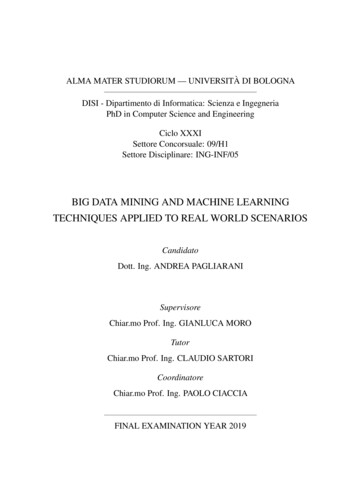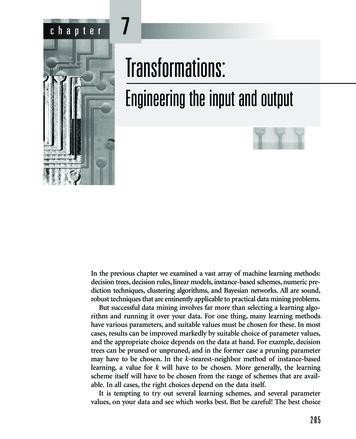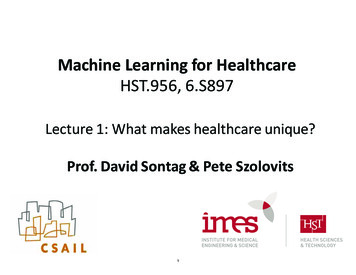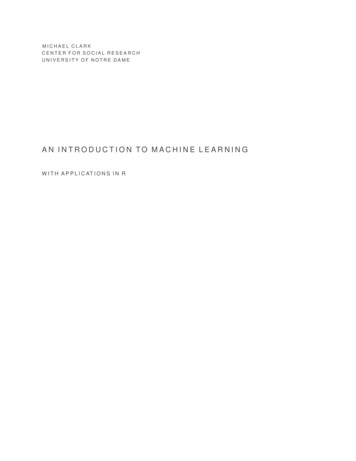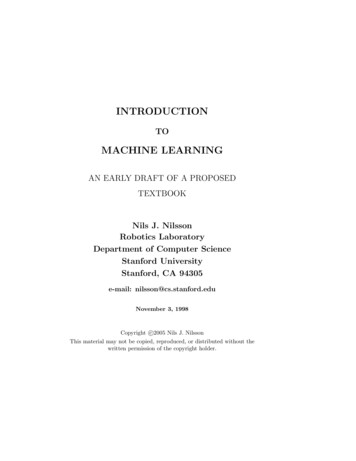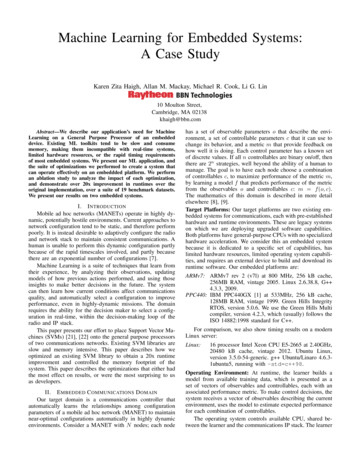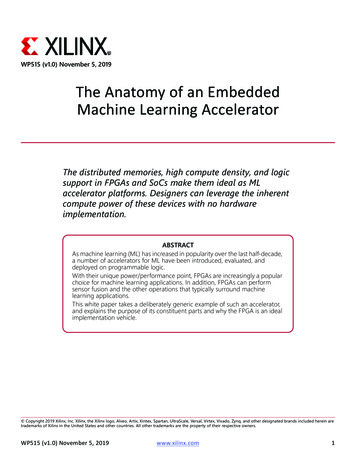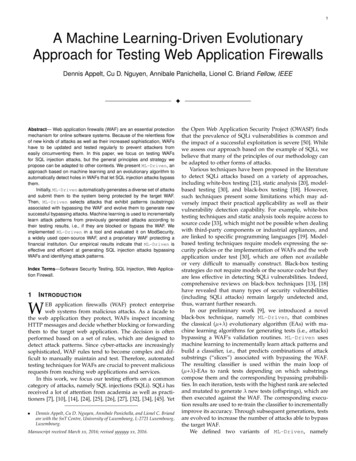
Transcription
1A Machine Learning-Driven EvolutionaryApproach for Testing Web Application FirewallsDennis Appelt, Cu D. Nguyen, Annibale Panichella, Lionel C. Briand Fellow, IEEEFAbstract— Web application firewalls (WAF) are an essential protectionmechanism for online software systems. Because of the relentless flowof new kinds of attacks as well as their increased sophistication, WAFshave to be updated and tested regularly to prevent attackers fromeasily circumventing them. In this paper, we focus on testing WAFsfor SQL injection attacks, but the general principles and strategy wepropose can be adapted to other contexts. We present ML-Driven, anapproach based on machine learning and an evolutionary algorithm toautomatically detect holes in WAFs that let SQL injection attacks bypassthem.Initially, ML-Driven automatically generates a diverse set of attacksand submit them to the system being protected by the target WAF.Then, ML-Driven selects attacks that exhibit patterns (substrings)associated with bypassing the WAF and evolve them to generate newsuccessful bypassing attacks. Machine learning is used to incrementallylearn attack patterns from previously generated attacks according totheir testing results, i.e., if they are blocked or bypass the WAF. Weimplemented ML-Driven in a tool and evaluated it on ModSecurity,a widely used open-source WAF, and a proprietary WAF protecting afinancial institution. Our empirical results indicate that ML-Driven iseffective and efficient at generating SQL injection attacks bypassingWAFs and identifying attack patterns.Index Terms—Software Security Testing, SQL Injection, Web Application Firewall.1I NTRODUCTIONWEB application firewalls (WAF) protect enterpriseweb systems from malicious attacks. As a facade tothe web application they protect, WAFs inspect incomingHTTP messages and decide whether blocking or forwardingthem to the target web application. The decision is oftenperformed based on a set of rules, which are designed todetect attack patterns. Since cyber-attacks are increasinglysophisticated, WAF rules tend to become complex and difficult to manually maintain and test. Therefore, automatedtesting techniques for WAFs are crucial to prevent maliciousrequests from reaching web applications and services.In this work, we focus our testing efforts on a commoncategory of attacks, namely SQL injections (SQLi). SQLi hasreceived a lot of attention from academia as well as practitioners [7], [10], [14], [24], [25], [26], [27], [32], [34], [45]. Yet Dennis Appelt, Cu D. Nguyen, Annibale Panichella, and Lionel C. Briandare with the SnT Centre, University of Luxembourg, L-2721 Luxembourg,Luxembourg.Manuscript received March xx, 2016; revised yyyyyy xx, 2016.the Open Web Application Security Project (OWASP) findsthat the prevalence of SQLi vulnerabilities is common andthe impact of a successful exploitation is severe [50]. Whilewe assess our approach based on the example of SQLi, webelieve that many of the principles of our methodology canbe adapted to other forms of attacks.Various techniques have been proposed in the literatureto detect SQLi attacks based on a variety of approaches,including white-box testing [21], static analysis [20], modelbased testing [30], and black-box testing [18]. However,such techniques present some limitations which may adversely impact their practical applicability as well as theirvulnerability detection capability. For example, white-boxtesting techniques and static analysis tools require access tosource code [33], which might not be possible when dealingwith third-party components or industrial appliances, andare linked to specific programming languages [19]. Modelbased testing techniques require models expressing the security policies or the implementation of WAFs and the webapplication under test [30], which are often not availableor very difficult to manually construct. Black-box testingstrategies do not require models or the source code but theyare less effective in detecting SQLi vulnerabilities. Indeed,comprehensive reviews on black-box techniques [13], [18]have revealed that many types of security vulnerabilities(including SQLi attacks) remain largely undetected and,thus, warrant further research.In our preliminary work [9], we introduced a novelblack-box technique, namely ML-Driven, that combinesthe classical (µ λ) evolutionary algorithm (EAs) with machine learning algorithms for generating tests (i.e., attacks)bypassing a WAF’s validation routines. ML-Driven usesmachine learning to incrementally learn attack patterns andbuild a classifier, i.e., that predicts combinations of attacksubstrings (“slices”) associated with bypassing the WAF.The resulting classifier is used within the main loop of(µ λ)-EAs to rank tests depending on which substringscompose them and the corresponding bypassing probabilities. In each iteration, tests with the highest rank are selectedand mutated to generate λ new tests (offsprings), which arethen executed against the WAF. The corresponding execution results are used to re-train the classifier to incrementallyimprove its accuracy. Through subsequent generations, testsare evolved to increase the number of attacks able to bypassthe target WAF.We defined two variants of ML-Driven, namely
2ML-Driven D and ML-Driven B, that differ in the numberof tests being selected for generating new tests (offsprings).The former variant selects fewer tests to evolve but generates more offsprings per selected test, thus increasing exploitation (deep search). The latter variant selects more teststo mutate, which results in a lower number of offspringsper selected test, hence increasing exploration (broad search).Our preliminary study with ModSecurity1 , a popular opensource WAF, has shown that both ML-Driven D andML-Driven B are effective in generating a large numberof distinct SQLi attacks passing thought the WAF. However,ML-Driven D performs better in the earlier stages of thesearch while ML-Driven B outperforms it in the last partof the search, for reasons we will explain.In the race against cyber-attacks, time is vital. Beingable to learn and anticipate attacks that successfully bypassWAFs in a timely manner is critical. With more successful,distinct attacks being detected, the WAF administrator isin a better position to identify missed attack patterns andto devise patches that block all further attacks sharing thesame patterns. Therefore, our goal is to devise a techniquethat can efficiently generate as many successful distinctattacks as possible. To this aim, in this paper we extended our prior work and propose an adaptive variantof ML-Driven, namely ML-Driven E (Enhanced), thatcombines the strengths of ML-Driven D (deep search) andML-Driven B (broad search) in an adaptive manner. InML-Driven E, the number of offsprings is computed dynamically depending on the bypassing probability assignedto each selected test by the constructed classifier. Conversely,ML-Driven B and D generate a fixed number of offspringsper attack/test. Therefore, ML-Driven E is a more flexibleapproach that better balances exploration over run time.Moreover, we conducted a much larger empirical studywith two popular WAFs that protect three open-sourceand 44 proprietary web services. The results show that theenhanced version of our technique (ML-Driven E) significantly outperforms: (i) its predecessors ML-Driven B andML-Driven D; (ii) a random test strategy, which serves asa baseline; (iii) two state-of-the-art vulnerability detectiontools, namely SqlMap and WAF Testing Framework. Wealso performed a qualitative analysis of the attacks generated by our approach and we found out that they enable theidentification of attack patterns that are strongly associatedwith bypassing the WAFs, thus providing better support forimproving the WAFs’ rule set.To summarize, the key contributions of this paper include: Enhancing ML-Driven with an adaptive test selection and generation heuristic, which more effectivelyexplores attack patterns with higher likelihood of bypassing the WAF. This enhanced ML-Driven variantis intended to replace its predecessors, leaving thepractitioners with a single, yet the best, option.Assessing the influence of the selected machinelearning algorithm on the test results by comparingtwo alternative classification models, namely RandomTree and RandomForest, which are both adapted1. https://www.modsecurity.org to large numbers of features and datasets, but withcomplementary advantages and drawbacks.Extending the previous evaluation and conducting alarge-scale experiment on a proprietary WAF protecting a financial institution.Comparing ML-Driven with SqlMap and WAFTesting Framework, which are state-of-the-artvulnerability detection tools.A qualitative analysis showing that the additionaldistinct attacks found by ML-Driven E help security analysts design better patches compared to theother ML-Driven variants, RAN, and state-of-theart vulnerability detection tools.The remainder of the paper is structured as follows.Section 2 provides background information on WAFs as wellas SQLi attacks and discusses related work. Section 3 detailsour approach followed by Section 4 where we describe thedesign and procedure of our empirical evaluation. Section 5describes the evaluation results and their implications regarding our research questions while Section 6 explains andillustrates how to use the generated attacks for repairingvulnerable WAFs. Further reflections on the results areprovided in Section 7 while Section 8 concludes this paper.2BACKROUND AND R ELATED W ORKIn this section, we provide background notions about SQLivulnerabilities and describe existing white-box and blackbox approaches aimed at uncovering them.2.1SQL Injection VulnerabilitiesIn systems that use databases, such as web-based systems,the SQL statements accessing back-end databases are usually treated as strings. These strings are formed by concatenating different string fragments based on user choicesor the application’s control flow. Once a SQL statement isformed, it is submitted to the database server to be executed.For example, a SQL statement can be formed as follows (asimplified example from one of our web services in the casestudy): sql "select * from hotelList wherecountry ’"; sql sql. country; sql sql."’"; result mysql query( sql) ordie(mysql error());The variable country is an input provided by the user,which is concatenated with the rest of the SQL statementand then stored in the string variable sql. The string isthen passed to the function mysql query that sends theSQL statement to the database server to be executed.SQLi is an attack technique in which attackers injectmalicious SQL code fragments into input parameters thatlack proper validation or sanitization. An attacker mightconstruct input values in a way that changes the behavior ofthe resulting SQL statement and performs arbitrary actionson the database (e.g. exposure of sensitive data, insertionor alteration of data without authorization, loss of data, oreven taking control of the database server).
3In the previous example, if the input country receivedthe attack payload ’ or 1 1 --, the resulting SQL statement is:select * from hotelListwhere country ’’ or 1 1 --’The clause or 1 1 is a tautology, i.e., the condition willalways be true, and is thus able to bypassing the originalcondition in the where clause, making the SQL query returnall rows in the table.Web Application Firewalls. Web applications with highsecurity requirements are commonly protected by WAFs. Inthe overall system architecture, a WAF is placed in front ofthe web application that has to be protected. Every requestthat is sent to the web application is examined by theWAF before it reaches the web application. The WAF handsover the request to the web application only if the requestcomplies with the firewall’s rule set.A common approach to define the firewall’s rule setis using a black-list. A black-list contains string patterns,typically defined as regular expressions. Requests recognized by these patterns are likely to be malicious attacks(e.g., SQLi) and, therefore, are blocked. For example, thefollowing regular expression describes the syntax for SQLcomments, e.g., /**/ or #, which are frequently used inSQLi attacks:/\*!? \*/ [’;]-- --[\s\r\n\v\f] (?:--[ -]*?-) ([ \-&])#.*?[\s\r\n\v\f] ;?\\x00There are several reasons why a WAF may provideinsufficient protection, including implementation bugs ormisconfiguration. One way to ensure the resilience of a WAFagainst attacks is to rely on an automated testing procedurethat thoroughly and efficiently detects vulnerabilities. Thispaper addresses this challenge for SQL injections, one of themain types of attacks in practice.2.2Related WorkPrevious research on ensuring the resilience of IT systemsagainst malicious requests has focused on the testing offirewalls as well as input validation mechanisms.Offutt et al. introduced the concept of Bypass Testing inwhich an application’s input validation is tested for robustness and security [38]. Tests are generated to intentionallyviolate client-side input checks and are then sent to theserver application to test whether the input constraints areadequately evaluated. Liu et al. [35] proposed an automatedapproach to recover an input validation model from program source code and formulated two coverage criteria fortesting input validation based on the model. Desmet etal. [17] verify a given combination of a WAF and a webapplication for broken access control vulnerabilities, e.g.forceful browsing, by explicitly specifying the interactionsof application components on the source code level and byapplying static and dynamic verification to enforce onlylegal state transitions. In contrast, we propose a blackbox technique that does not require access to source codeor client-side input checks to generate test cases. In ourapproach, we use machine learning to identify the patternsrecognized by the firewall as SQLi attacks and generatebypassing test cases that avoid those patterns.Tripp et al. [48] proposed XSS Analyzer, a learningapproach to web security testing. The authors tackle theproblem of efficiently selecting from a comprehensive inputspace of attacks by learning from previous attack executions.Based on the performed learning, the selection of newattacks is adjusted to select attacks with a high probabilityof revealing a vulnerability. More specifically, XSS Analyzergenerates attacks from a grammar and learns constraintsthat express which literals an attack cannot contain in orderto evade detection. The authors find that XSS Analyzeroutperforms a comparable state-of-the-art algorithm, thus,suggesting that learning input constraints (a concept similarto the path conditions in ML-Driven) is effective to guidethe test case generation.In contrast to our work, XSS Analyzer applies learningto individual literals only while our approach also learnsif a combination of literals is likely to bypass or be blocked.Therefore, XSS Analyzer cannot capture more complex inputconstraints involving multiple literals simultaneously, e.g.,an attack should contain literal a, but not b and c in order toevade detection. Furthermore, to analyze which literals inan attack are blocked, XSS Analyzer first splits each attackinto its composing tokens; then, it resends each token to thetarget web application. Since multiple attacks can share thesame tokens, XSS Analyzer sends each token only once toavoid performing the same analysis multiple times. Thisprocedure consumes a large quantity of HTTP requests. Incontrast, ML-Driven does not require to resubmit individual slices, but learns path conditions solely from previouslyexecuted test case and, thus, spends its test budget moreefficiently. In addition, there are differences between XSSAnalyser and ML-Driven in terms of objectives: The formeraddresses cross-site scripting sanitization in web applications, while the latter addresses the detection of SQLi attacksin WAFs.In grammar-based testing, a strategy typically samples alarge input space defined by a grammar. Several grammarbased approaches exist in the literature for testing securityproperties of an application under test [37], [47]. Godefroid et al. [23] proposed white-box fuzzing, which startsby executing an application under test with a given wellformed input and uses symbolic execution to create inputconstraints when conditional statements are encountered onthe execution path. Then, new inputs are created that exercise different execution paths by negating the previouslycollected constraints. The implementation of the approachfound a critical memory corruption vulnerability in a fileprocessing application. In a follow-up work, the authorspropose grammar-based white-box fuzzing [21], which addresses the generation of highly structured program inputs.In this work, well-formed inputs are generated from a grammar and the constraints created during execution are expressed as constraints on grammar tokens. To generate newinputs, a constraint solver searches the grammar for inputsthat satisfy the constraints. The authors implemented theirwork in a tool named SAGE and found several securityrelated bugs [22]. In contrast to the mentioned work ofGodefroid et al., our work does not require access to thesource code of the application under test, which is in many
4practical scenarios not available, but proposes a black-boxapproach based on machine learning to efficiently samplethe input space defined by an attack grammar.The topic of testing network firewalls has also beenaddressed by an abundant literature. Although networkfirewalls operate on a lower layer than application firewalls,which are our focus, they share some commonalities. Bothuse policies to decide which traffic is allowed to pass orshould be rejected. Therefore, testing approaches to findflaws in network firewall policies might also be applicableto web application firewall policies. Bruckner et al. [1]proposed a model-based testing approach which transformsa firewall policy into a normal form. Based on case studiesthey found that this policy transformation increases theefficiency of test case generation by at least two orders ofmagnitude. Hwang et al. [29] defined structural coveragecriteria of policies under test and developed a test generation technique based on constraint solving that tries tomaximize structural coverage. Other research has focusedon testing the firewalls implementation instead of policies.Al-Shaer et al. [3] developed a framework to automaticallytest if a policy is correctly enforced by a firewall. Therefore,the framework generates a set of policies as well as testtraffic and checks whether the firewall handles the generated traffic correctly according to the generated policy.Some authors have proposed specification-based firewalltesting. Jürjens et al. [30] proposed to formally model thetested firewall and to automatically derive test cases fromthe formal specification. Senn et al. [43] proposed a formallanguage for specifying security policies and automaticallygenerate test cases from formal policies to test the firewall.In contrast, in addition to targeting application firewalls, ourapproach does not rely in any models of security policiesor the firewall under test, such formal models are rarelyavailable in practice.3A PPROACHThis section introduces an approach for testing WAFs. Section 3.1 defines the input space for this testing problemas a context-free grammar. Section 3.2 presents a simpleattack generation strategy that randomly samples the inputspace and serves as baseline. Section 3.3 presents two testgeneration strategies that make use of machine learningto guide test generation towards areas in the input spacethat are more likely to contain successful attacks. Finally,Section 3.4 details an approach to combine such attackgeneration strategies to achieve better results.3.1A Context-Free Grammar for SQLi AttacksSQ
a widely used open-source WAF, and a proprietary WAF protecting a financial institution. Our empirical results indicate that ML-Drivenis effective and efficient at generating SQL injectio

